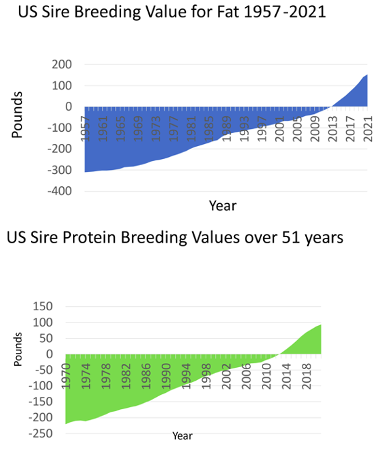Research Note

Proactive Formulation for the 44,000 lb Cow
In every dairy herd, every breeding is an opportunity to increase the herd’s milk yield and milk components. Capturing such dynamic potential requires increasingly accurate diet formulation.
“Milk yield requires pregnancy,” says Cornell’s Dr. Mike Van Amburgh, “which means every unit of semen has the potential to produce genetically superior offspring.”
In effect, Van Amburgh says, the “cow is the innovation” and constantly advancing in performance: “However, we don’t yet manage the interaction between the cow and her diet in a proactive manner. We’re usually ‘playing catch-up’ to her genetic potential — especially in the age of genomic selection.”
Van Amburgh points to studies estimating that modern Holsteins have genetic capacity for milk yield of more than 34,000 kg (75,000 lbs) per lactation. He notes that commercial dairies in New York’s Cayuga County already have Holsteins peaking at 175-200 lbs (80-90 kg) per day, which would approach 44,000 lbs depending on lactation persistency.
Moreover, the record of yield improvement in Holsteins applies to milk fat and milk protein, too, as shown in food science research from Cornell.

Adapted from Dechow, 2023 (https://webconnect.uscdcbcom
/#/summarystats/genetic-trend)
Holsteins also happen to offer “economies of scale” advantages — greater milk yield and potentially more milk components per unit of intake, thereby reducing intensity of greenhouse gas emissions.
Producers already are adjusting Holstein rations to optimize milk components for particular markets — for example, formulating for higher milk protein concentration to supply the cheddar cheese market in the Northeast.
“As demands for milk and component yields increase, the precision needed for diet formulation also needs to increase. This is true for amino acids and is going to apply to fatty acids once we better understand the requirements.”
Van Amburgh notes recent data that suggests accurately meeting AA requirements enhances energetic efficiency more than nitrogen efficiency. He offers the following steps to optimize energetic efficiency using the Cornell Net Carbohydrate and Protein System (CNCPS) model:
- Determine the most limiting nutrient — energy or protein (cows and model should agree)
- Evaluate the rumen N balance and urinary N excretion — if high, then work to reduce the soluble protein (within CNCPS rumen NH3 balance of 120‐140%)
- If grams MP is in excess, then decrease MP from feed in small increments
- Given ME and MP in balance with acceptable rumen N balance, then focus on AA
- For methionine, use 1.15‐1.19 g MP Met per Mcal ME (CNCPS v6.55)
- For lysine, maintain Lys:Met (ratio) of about 2.7:1
- Pay attention to aNDFom digestibility, allocating highest digestibility forages to fresh and high producing cows
More on nitrogen efficiency versus AA and energetic efficiency at the upcoming 2024 Cornell Nutrition Conference.
Questions?
Email FeedInsight 4U

